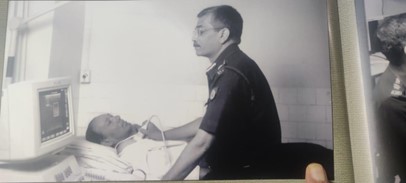Seeing is Believing—But Is It Legal?

(Lt General) Ved Chaturvedi MD, DM Clinical Immunology & Rheumatology
Senior Consultant, Rheumatologist, Sir Ganga Ram Hospital, New Delhi
Can a rheumatologist in India legally perform ultrasound?
Ultrasound has become an essential tool in rheumatology. Just as cardiologists use echocardiography and obstetricians use ultrasound for fetal imaging, rheumatologists use ultrasound for better diagnosis and treatment. Clinical examination alone is sometimes inadequate, and ultrasound provides real-time imaging, improving accuracy in detecting joint effusions, synovitis, and guiding procedures like injections.
While radiologists have traditionally been the primary users, a Supreme Court ruling clarified that non-radiologists can perform ultrasound, provided they have undergone adequate training.
Following requirements must be fulfilled to perform ultrasound:
- Complete at least 6 months of training in ultrasound.
- Perform a minimum of 500 documented scans under the supervision of a qualified radiologist.
- Obtain a certificate from the supervising radiologist confirming the completion of the required scans.
What are the compliances needed while performing ultrasound in practice?
When incorporating ultrasound into practice, it is essential to comply with PCPNDT (Pre-Conception and Pre-Natal Diagnostic Techniques) regulations to avoid legal issues. Every ultrasound machine should have a visible notice stating that certain types of scans (such as fetal imaging) are not performed. Additionally, proper registration is required.
In a hospital setting, the hospital administration should be informed about ultrasound use, and formalities should be completed under the hospital’s PCPNDT compliance. If a rheumatologist operates independently, their legal name must be registered accordingly. A logbook must be maintained with details of each scan, including patient names and diagnoses. Keeping records ensures transparency and compliance.
How can the Indian Rheumatology Association (IRA) help standardize ultrasound training?
While the utility of ultrasound is undeniable, its practice in rheumatology needs to be better organized and standardized. If we fail to take ownership of it, other specialties will dominate the field. Just as Prof Dr. A.N Chandrashekaran from Chennai pioneered the DM Rheumatology program, leading to widespread recognition, the Indian Rheumatology Association (IRA) must act now.
A structured IRA-led ultrasound training program should be established, possibly in collaboration with EULAR. One approach could be,
- Tying up with EULAR to create an IRA-EULAR course with a mix of Indian and international faculty.
- Gradually developing a standalone IRA certification over time.
- Incorporating ultrasound into DM and DNB rheumatology training, ensuring that it is formally examined.
Many institutions still lack ultrasound machines in their departments, often because the department head is unfamiliar with the technology. However, ultrasound should not be dismissed for this reason—it is simply a tool that can be learned, much like any other diagnostic skill.
If ultrasound is made a formal part of rheumatology training, with documented competencies and supervised assessments, it will be easier to justify its practice legally. Cardiologists perform echocardiography as part of their curriculum—why should rheumatologists be any different with musculoskeletal ultrasound?
Can rheumatologists formally report ultrasound findings?
Yes. Providing ultrasound as a service is no different from performing a joint injection or a lip biopsy. Reporting can be done formally or informally. While busy clinicians may simply note findings on an OPD slip, it is preferable to use standardized report formats for clarity and professionalism. Patients often expect a printed report, and a simple template can make a big difference.
One practical tip is to encourage patients to take pictures of their scans with their mobile phones. This saves time and provides them with immediate access to their imaging. Clinicians should also feel confident in their reporting. No one understands the clinical relevance of ultrasound findings in rheumatology better than a rheumatologist. While there may be hesitation in grading synovial hypertrophy or erosions, it is better to report what is confidently observed rather than avoid documentation altogether.
Should rheumatologists collaborate with radiologists or maintain independence?
While rheumatologists should gain expertise in ultrasound, it is equally important to maintain good relationships with radiologists. Instead of asserting superiority, it is beneficial to collaborate and involve them in institutional training programs. A confrontational approach, where rheumatologists claim expertise over radiologists, is counterproductive. Mutual respect ensures smoother working relationships and better patient outcomes.
At the same time, rheumatologists must take ownership of ultrasound training within their specialty. If we do not formalize this education, radiologists or other specialists will fill the gap. Structured training, curriculum integration, and collaborative efforts with established institutions like EULAR can ensure that ultrasound becomes a standard part of rheumatology practice.
For rheumatologists what’s the best way to get started?
For rheumatologists looking to integrate ultrasound into their practice, the first step is simple: purchase a machine. Just as learning to drive requires owning a car, mastering ultrasound requires access to a machine. In government institutions, this process is easier, but in private practice, one must justify the investment.
To make a financial case for ultrasound, one can explain that each scan typically costs around ₹1,700 to ₹2,000. Over time, the machine pays for itself while significantly improving diagnostic accuracy. Additionally, incorporating ultrasound enhances a rheumatologist’s reputation and credibility.
Once a machine is available, learning begins. Rheumatologists should start by practicing independently and then enroll in structured training programs. Courses such as the EULAR Basic Ultrasound Course, APLAR training, or the IRA workshops at IRACON are valuable starting points. Gradually, proficiency develops—much like learning to drive.
Finally, what does the future hold for ultrasound in rheumatology?
Rheumatologists should incorporate ultrasound into daily practice. At present, ultrasound is used in approximately 10–20% of rheumatology cases, but as technology advances, this percentage is likely to increase.
Rheumatology is a vast specialty, involving multiple organ systems beyond joints. Besides clinical examination, bedside imaging is one of the most powerful tools available. As ultrasound technology continues to evolve, its role in rheumatology will only expand, making it an essential skill for every rheumatologist.

Rheumatology Ultrasound first time in India by Dr [Col] Ved Chaturvedi at Army Hospital New Delhi [2003]

